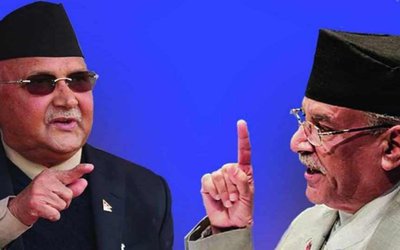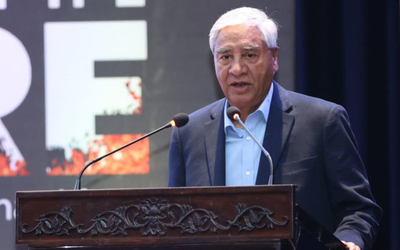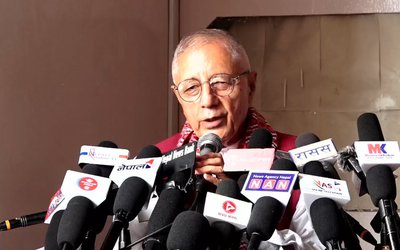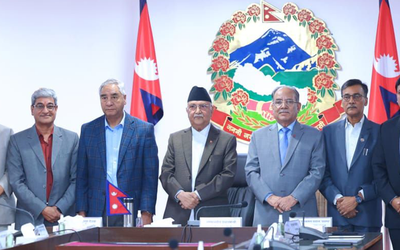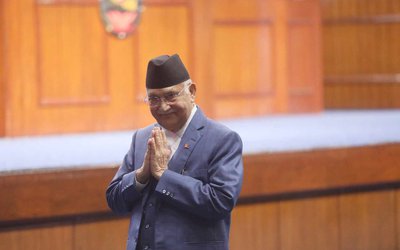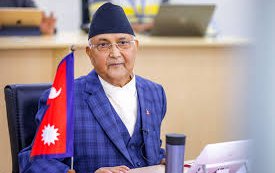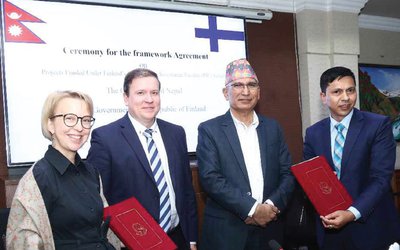
The visit of Chinese President Xi, the leader of the world’s second largest economy and key global player, to Nepal has secured a global attention. At a time when Xi visited Nepal, the government is led by Nepal Communist Party with two thirds of majority in the elected House of Representatives. Out of 7 provinces, six provinces and over 50 percent local levels are under NCP control.
Whether one likes it or not, Nepal likes red serfdom. The visit has attracted global attention, but more attention from Nepal’s southern neighbor. Such attention and concern of the global powers on the visit of a powerful leader like Xi was natural.
The great loser in Nepal’s recent dynamics is India, which has close geographical, religious, historical and cultural relations with Nepal. India shares, among others, civilization with Nepal.
Although India had alliance of all the Communists and Nepali Congress to abolish the monarchy, which used to represent India’s all soft powers in Nepal, hoping to bring more friendly party in power, it has been a great loser.
As monarchy has gone as a traditional force and Nepali Congress is weakened badly, losing its vote banks, the rise of communists is ideologically advantageous for China. India’s blunder of 2006 gave a new space to China to increase its influence in Nepal.
Although BRI and Indo-Pacific Alliance are economy-related agenda, NCP leaders have expressed commitment to China on BRI, terming Indo-Pacific military kind of alliance. Pursued by United States of America, Indo-Pacific Alliance is a program for broader economic integration with the US and likeminded countries. If Nepal takes advantage of BRI, what is wrong to go for Indo-Pacific to get economic benefits?

Chinese have been repeatedly pursuing cultural, religious and historical linkages with Nepal. For the first time, Nepali President Bidya Devi Bhandari not only acknowledged this but also said Nepal is following Xi’s thought to pursue its developmental path.
India has extensive influence on Nepal's economy and politics, while China and Nepal share a border covered with high mountain peaks.
Jiang Zemin had been the last Chinese president to visit Nepal, making the trip in 1996, but other Chinese leaders — including premiers and foreign ministers — have since paid official visits to the Himalayan nation.
Tanka Prasad Karki, a former Nepali diplomat, said that a Chinese president had not visited Nepal in such a long time because "China was waiting for a strong government in Kathmandu, as the last few decades were marked by a Maoist war, frequent changes of government and political instability."
“Trans-Himalayan connectivity and an extradition treaty will be high on the agenda during official talks on Sunday,” said Narayan Kaji Shreshta, spokesman for the ruling Nepal Communist Party. “The countries are also expected to sign a project report on constructing a rail link between Kathmandu and Keyrung in Tibet.”
From China’s perspective, landlocked Nepal is strategically located in South Asia, along India’s northern border and beside Tibet.
“The Chinese are offering huge economic incentives during this visit, but they are injecting their own interests, too,” said Mrigendra Bahadur Karki, head of the Centre for Nepal and Asian Studies at Tribhuvan University in Kathmandu.
Co-chairman of Nepal Communist Party Pushpa Kamal Dahal Prachanda said that Nepal cannot allow its soil to be used in anti-China activities. While paying a courtesy call to Chinese President Xi Jinping, former Prime Minister Dahal said that there is no space for anybody to use Nepal against China.
Dahal also stressed the need to further strengthen Nepal-China relations to take them to a new height. Chinese president Xi said that Chinese and Nepali Communist Parties are able to rule the country by winning the hearts of the people.
Visiting Chinese President Xi Jinping said that the feasibility study of cross-border railway between the two countries would be conducted.

Maintaining that China would expedite the development of Trans-Himalayan Multi-Dimensional Connectivity infrastructure, he said, “We want to support Nepal in realizing its dream to become a land-linked country from the landlocked country.”
He announced that China will provide support in conducting the feasibility study of Keyrung-Kathmandu railway, upgrading the Arniko Highway and constructing Keyrung-Kathmandu tunnel way.
President Xi expressed his commitment to further support post-quake reconstruction, Visit Nepal Year 2020, education sector and urban development in the country.
President Bhandari said that the land of Lord Buddha expected Chinese support in developing Lumbini as a centre of world peace, and infrastructure improvement for cross-border connectivity.
“Nepali people want to see Rasuwagadhi-Kathmandu-Lumbini railway connectivity happening,” she said.
Chinese President Xi also announced a package of 56 billion rupees support to Nepal to improve infrastructure and connectivity.

Constantino Xavier, a foreign policy fellow at Brookings India in New Delhi, said, “China is seeking to find a sweet spot: to increase its influence in Nepal without upsetting India’s security concerns in what used to be its predominant sphere of influence.”
The balance is tricky. China and India have historically jockeyed for influence in Nepal, and they share their own sources of tension.
Rajan Bhattarai, foreign affairs adviser to PM Oli, said that in addition to the railway project, Nepal expected to sign deals with China that could transform the entire Himalayan region by revamping underperforming hydropower, energy and transit industries.
“Friendship with all, enmity with none: It’s a core principle of our foreign policy,” he said. “Since the last Chinese president visited Nepal in 1996, things have significantly changed with China in terms of its role in regional and international affairs.”
Rhetoric and reality are two different things. Reality always prevails. Nepal has its own limitations. This is what Xi’s visit shows.
- PM Oli's Visit To China: Geopolitical Implications
- Nov 19, 2024
- NEA: Kul Man Ghising, A Cool Man
- Oct 28, 2024
- DASHAIN FESTIVAL : Festival of Unity
- Oct 04, 2024
- NEPAL-CANADA Bilateral Meeting
- Oct 04, 2024
- MIDDLE BHOTEKOSHI: Final Stage
- Sep 23, 2024


